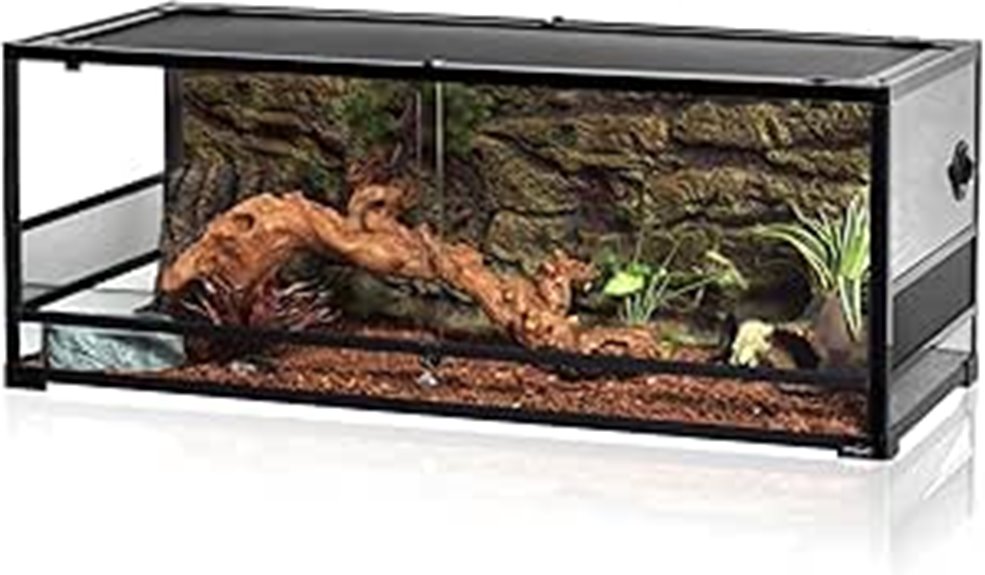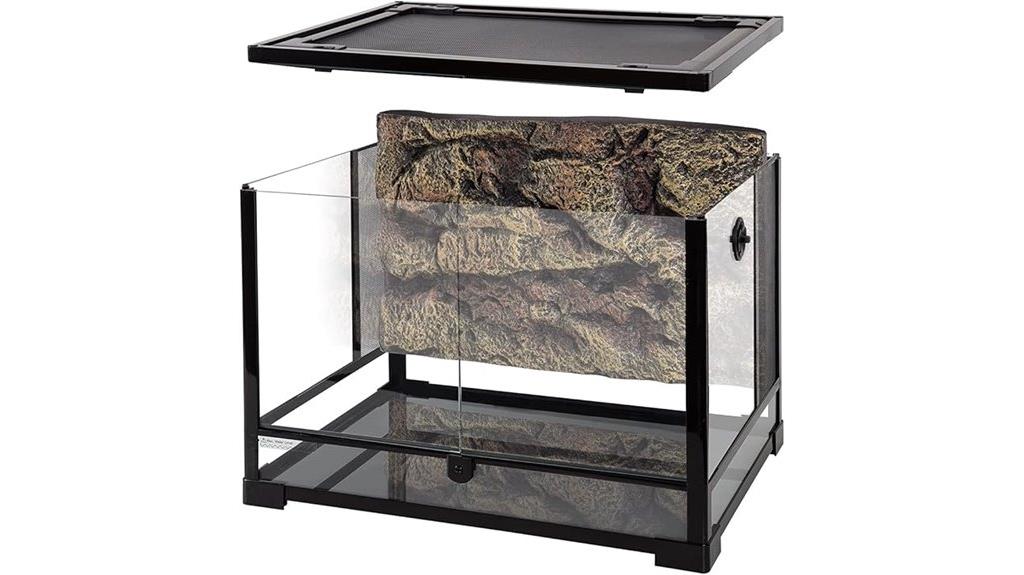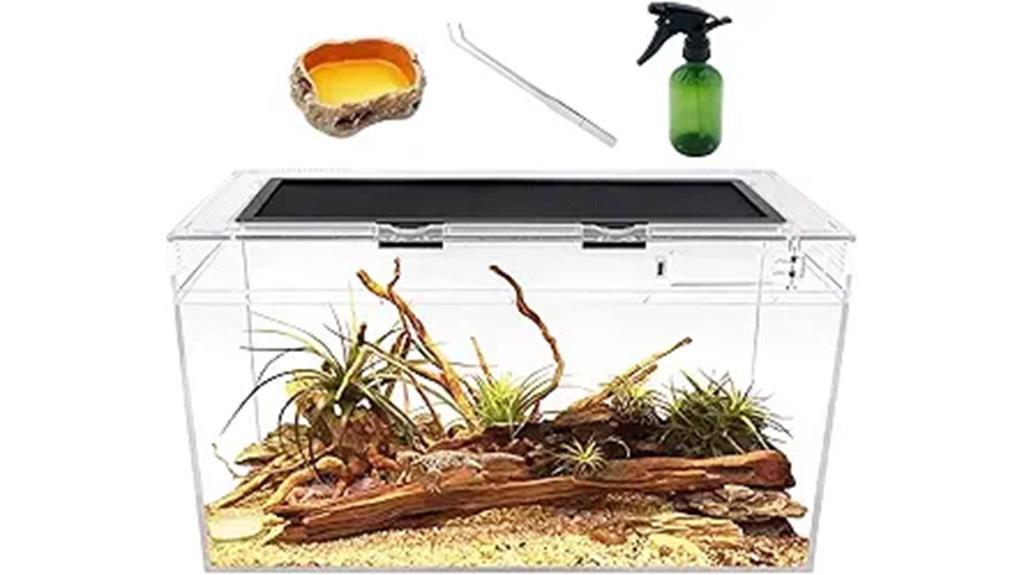You’ll want top-tier reptile tanks that prioritize your pet’s health and happiness in 2025. The Repti Zoo 67-Gallon Glass Terrarium offers spacious, secure living with tempered glass and raised frames for substrate heaters. The 24 x 18 x 18 Repti Zoo tank provides excellent ventilation and locked doors. The 10-Gallon Reptile Terrarium works great for smaller species, including bonus accessories. Curious about which tank matches your reptile’s unique needs? Stick around.
Key Takeaways
- Choose a tank size proportional to your reptile’s adult dimensions, ensuring adequate space for natural movement and behavioral expression.
- Prioritize tempered glass constructions with sturdy screen tops that provide optimal ventilation, durability, and resistance to temperature variations.
- Select tanks with raised bottom frames to accommodate substrate heaters and facilitate essential habitat temperature regulation for reptilian health.
- Consider species-specific design requirements, such as vertical climbing spaces for arboreal reptiles or wider floor areas for terrestrial species.
- Invest in tanks featuring secure access mechanisms like front sliding doors with locks to prevent escapes and ensure pet safety.
REPTI ZOO Large Reptile Glass Terrarium (67 Gallon)

If you’re searching for a spacious, versatile reptile habitat that can accommodate a wide range of scaly companions, the REPTI ZOO Large Reptile Glass Terrarium stands out as a top-tier choice. With its 67-gallon capacity and 48 x 18 x 18 inch dimensions, this terrarium offers ample room for snakes, lizards, geckos, and amphibians. Its tempered glass construction and tough screen top provide durability and ideal ventilation. Front sliding doors with a lock guarantee secure access, while the raised bottom frame accommodates substrate heaters. Easy assembly and careful packaging make this terrarium a practical solution for reptile enthusiasts.
Best For: Reptile and amphibian owners seeking a spacious, high-quality, and versatile glass terrarium that can accommodate a wide range of species.
Pros:
- Large 67-gallon capacity with excellent ventilation and customizable habitat options
- Durable tempered glass construction with secure front sliding doors and lock
- Easy 5-minute assembly and compatibility with various reptile and amphibian species
Cons:
- May be too large for small living spaces or beginners with limited reptile experience
- Higher price point compared to basic plastic terrariums
- Requires additional accessories like heating and lighting equipment for complete habitat setup
https://www.amazon.com/dp/B07KP2D42W
REPTI ZOO Large Reptile Glass Terrarium Tank (24 x 18 x 18)

Serious reptile enthusiasts looking for a versatile and high-quality habitat should zero in on the REPTI ZOO Large Reptile Glass Terrarium Tank. Its 24 x 18 x 18 dimensions make it perfect for turtles, lizards, snakes, and amphibians. You’ll appreciate the double hinge doors with screen ventilation, allowing easy feeding while preventing escapes. The tough screen top enables UVB and infrared penetration, vital for your pet’s health. With a waterproof bottom, raised frame for substrate heaters, and foam backgrounds simulating natural rock, this terrarium offers professional-grade housing that’ll keep your reptilian friend comfortable and secure.
Best For: Reptile and amphibian owners seeking a professional-grade, spacious, and versatile glass terrarium that accommodates a wide range of species like turtles, lizards, snakes, and frogs.
Pros:
- Large 34-gallon size with flexible dimensions suitable for multiple reptile and amphibian species
- Advanced ventilation features including screen top and window inlets for optimal environmental control
- Durable construction with waterproof bottom, raised heater frame, and high-density foam background
Cons:
- Relatively heavy at 35.1 pounds, which might make repositioning challenging
- May require additional accessories for specific habitat requirements
- Higher price point compared to basic plastic or mesh terrariums
https://www.amazon.com/dp/B07KSQZ8SC
Reptile Terrarium 10 Gallon Tank for Various Reptiles and Insects

Reptile enthusiasts seeking a versatile and compact habitat will find the 10 Gallon Reptile Terrarium an exceptional solution for housing a wide range of small pets. With its water-tight design and metal screen top, this terrarium supports animals from jumping spiders to bearded dragons. The explosion-proof crystal PC base offers durability, while its temperature resistance from -20°C to 120°C guarantees a stable environment. Its convenient feeding port with magnetic spring and included accessories like water dish and spray bottle make pet care straightforward. Whether you’re housing insects, reptiles, or small amphibians, this terrarium delivers functionality and adaptability.
Best For: Small reptile and insect enthusiasts seeking a compact, versatile habitat for various small pets like jumping spiders, leopard geckos, hermit crabs, and bearded dragons.
Pros:
- Durable explosion-proof crystal PC base with wide temperature resistance (-20°C to 120°C)
- Convenient feeding port with magnetic spring and included accessories
- Versatile design suitable for multiple types of small pets and habitats
Cons:
- Limited to 10-gallon capacity, which may not accommodate larger reptiles
- Might require additional heating or lighting equipment depending on specific pet needs
- Single size option may not suit all pet owner preferences
https://www.amazon.com/dp/B09MQBB6CP
Factors to Consider When Selecting Reptile Tanks
When choosing a reptile tank, you’ll need to carefully evaluate several critical factors that directly impact your pet’s health and comfort. Tank size, habitat compatibility, and proper ventilation are essential considerations that can make or break your reptile’s living environment. You’ll want to pay close attention to material durability, temperature gradient potential, and how these elements work together to create an ideal habitat for your specific reptile species.
Tank Size Matters
Picking out the right tank size can make or break your reptile’s quality of life. You’ll want to match the enclosure to your pet’s adult size, ensuring they’ve got room to move, explore, and exhibit natural behaviors. Small reptiles like geckos thrive in 10-20 gallon tanks, while larger species such as iguanas demand 75-gallon or bigger spaces. Don’t underestimate vertical requirements either—arboreal reptiles need taller enclosures compared to ground-dwelling ones.
An inappropriately sized tank can trigger stress and health issues. Too small, and your reptile feels cramped; too large, and maintaining proper temperature becomes challenging. Consider your pet’s expected adult size, activity level, and specific habitat needs when selecting the perfect tank. Your reptile’s well-being depends on it.
Habitat Type Compatibility
Because habitat diversity among reptiles is so vast, selecting the right tank isn’t a one-size-fits-all proposition. You’ll need to match your tank’s design to your reptile’s specific environmental needs. Arboreal species require taller enclosures with vertical climbing spaces, while terrestrial reptiles demand wider floor areas. If you’re housing aquatic or semi-aquatic creatures, guarantee sufficient water depth and appropriate aquatic landscaping. Desert dwellers thrive in well-ventilated tanks with low humidity and strategic heat zones, whereas rainforest inhabitants need high-moisture environments with dense vegetation. Pay close attention to temperature gradients, substrate requirements, and ventilation characteristics. Your tank’s configuration should mimic your pet’s natural habitat, providing comfort, security, and opportunities for species-specific behaviors.
Ventilation and Airflow
After establishing the right habitat layout for your reptile, airflow becomes the next critical design consideration. You’ll want to prioritize proper ventilation to guarantee your pet’s respiratory health and comfort. Screen tops, strategically placed windows, and adjustable inlets can help you control air circulation effectively.
Different reptile species have unique ventilation requirements, so you’ll need to tailor your tank’s design accordingly. Poor airflow can quickly lead to dangerous conditions like gas buildup, mold growth, and stagnant air that can jeopardize your reptile’s well-being. By selecting a tank with adequate ventilation, you’ll create an environment that supports your pet’s natural thermoregulation and helps prevent respiratory complications.
Choose wisely to keep your scaly friend healthy and thriving.
Material Durability Concerns
While durability might seem like a mundane consideration, selecting the right tank material can profoundly impact your reptile’s long-term health and comfort. Tempered glass emerges as a top choice, offering superior resistance to cracking and shattering compared to regular glass. You’ll want to avoid acrylic tanks, which can scratch easily and warp over time, compromising both visibility and structural integrity.
For larger enclosures, consider tanks with metal frames that provide additional strength and prevent sagging. High-quality thick plastic or fiberglass tanks can also offer excellent durability. Herpetologists consistently recommend glass terrariums for their resilience in humid environments, ease of cleaning, and transparent viewing surfaces. Your careful material selection guarantees a safe, long-lasting habitat that supports your reptile’s well-being.
Temperature Gradient Control
When setting up a reptile tank, you’ll want to nail down the indispensable aspect of temperature gradient control. Your cold-blooded pet relies on external heat sources to regulate body temperature, so creating a precise thermal environment is vital. You’ll need to design a tank with a warm basking area and a cooler retreat zone that allows your reptile to move and self-regulate.
Implement a strategic heating approach using heat lamps, under-tank heaters, and a reliable thermostat to maintain consistent temperatures. Place temperature sensors at different tank locations to monitor and adjust heat sources. This approach guarantees your reptile can move between warmer and cooler areas, supporting its physiological needs and overall health.
Access and Security
One critical aspect of selecting the right reptile tank is ensuring robust access and security features. You’ll want to prioritize tanks with secure doors or lids that prevent your pet from escaping. Look for front-opening doors or sliding panels that’ll make feeding and handling easier while maintaining a tight seal.
Check that ventilation openings are covered with sturdy screen material to block potential escape routes. The door’s design and locking mechanism are essential – they should allow you to securely close and latch the tank. Verify the tank’s materials are durable enough to withstand your reptile’s potential escape attempts.
Ultimately, your pet’s safety depends on a well-constructed, secure enclosure that keeps them contained while providing necessary airflow and accessibility.
Substrate Heater Compatibility
Because maintaining proper temperature is essential for reptile health, substrate heaters play a pivotal role in creating an ideal habitat. When selecting a reptile tank, you’ll want to prioritize models with a raised bottom frame that easily accommodates these pivotal heating elements.
Your tank’s design should facilitate even heat distribution, ensuring your pet can effectively thermoregulate. Look for tanks constructed with materials that support uniform heat transmission and provide stable temperature gradients. A well-designed tank with substrate heater compatibility will help your reptile maintain optimal body temperature, which is indispensable for digestion, metabolism, and overall well-being.
Carefully consider the tank’s dimensions and structural features to guarantee seamless substrate heater integration and create a comfortable environment for your scaly companion.
Species-Specific Requirements
Just as substrate heaters demand careful tank selection, reptile species present their own unique habitat prerequisites that can’t be overlooked. Your chameleon won’t thrive in the same environment as a bearded dragon, so you’ll need to match the tank to the specific species.
Arboreal reptiles require tall, vertical enclosures that let them climb and explore, while terrestrial species need wider floor spaces. Aquatic reptiles need specialized tanks with proper water depth, filtration systems, and docking areas. Consider your reptile’s size to prevent overcrowding, which can cause significant stress.
Ventilation is vital for maintaining optimal habitat conditions. UVB light penetration and air circulation will directly impact your pet’s health and well-being. By understanding these species-specific requirements, you’ll create a comfortable, thriving environment for your reptilian companion.
Frequently Asked Questions
How Often Should I Clean My Reptile’s Tank?
You’ll want to clean your reptile’s tank regularly to keep your pet healthy. Spot clean daily, removing waste and uneaten food. Do a thorough deep clean every 2-4 weeks, depending on your reptile species. Replace substrate, disinfect surfaces, and check for any signs of mold or bacterial growth. Don’t forget to wash your hands before and after cleaning to prevent contamination.
Can I Use Regular Glass Tanks for Reptiles?
Did you know that 68% of reptile owners initially use glass tanks? While they can work, they’re not always ideal. You’ll want to ponder your specific reptile’s needs. Regular glass tanks might not provide proper ventilation, temperature control, or humidity levels. Some species require specialized enclosures with specific features like mesh tops or precise heat gradient capabilities. Always research your pet’s exact environmental requirements before setting up their habitat.
What Lighting Is Best for Different Reptile Species?
You’ll want to match lighting to your specific reptile’s needs. Bearded dragons thrive with UVB and basking lights that mimic desert conditions. Tropical species like chameleons require different spectrum lighting with higher humidity considerations. Always research your pet’s native habitat and get specialized reptile bulbs that provide both heat and UVB radiation. Don’t skimp on quality—proper lighting supports metabolism, vitamin D synthesis, and overall health.
How Do I Control Humidity in a Reptile Tank?
Groovy, humidity control’s vital! You’ll want to use a hygrometer to monitor moisture levels precisely. Mist your tank regularly, but don’t overdo it. Add a substrate that retains moisture like coconut fiber or sphagnum moss. For some species, you’ll need a humidity box or hide. Use a spray bottle or automated misting system to maintain consistent levels. Different reptiles need different humidity ranges, so research your specific pet’s requirements.
Are Second-Hand Reptile Tanks Safe to Use?
When considering a second-hand reptile tank, you’ll want to be cautious. Check for cracks, scratches, or potential damage that could compromise the enclosure’s integrity. Thoroughly clean and disinfect the tank using reptile-safe cleaning solutions. Inspect seals and guarantee there are no lingering odors or residues from previous inhabitants. If the tank passes your rigorous inspection, it can be a cost-effective option for your scaly friend.
Conclusion
Choose your reptile’s palace wisely, or risk turning your scaly friend into a cramped, grumpy diplomat trapped in a shoebox embassy. These tanks aren’t just glass boxes; they’re five-star habitats where your cold-blooded companion can stretch, explore, and live like reptilian royalty. Don’t settle for less – your gecko’s diplomatic immunity depends on spacious, well-designed real estate!

Maria is brilliant when it comes to creating beautiful and functional spaces. Maria has an exceptional ability to understand your needs and desires, translating them into tailored solutions that reflect your personality and lifestyle. Whether you’re seeking advice on home decor, looking to upgrade your interior, or seeking inspiration to enhance your quality of life through design, Maria can help you achieve your goals. With Maria by your side, your vision for the perfect home is within reach.
